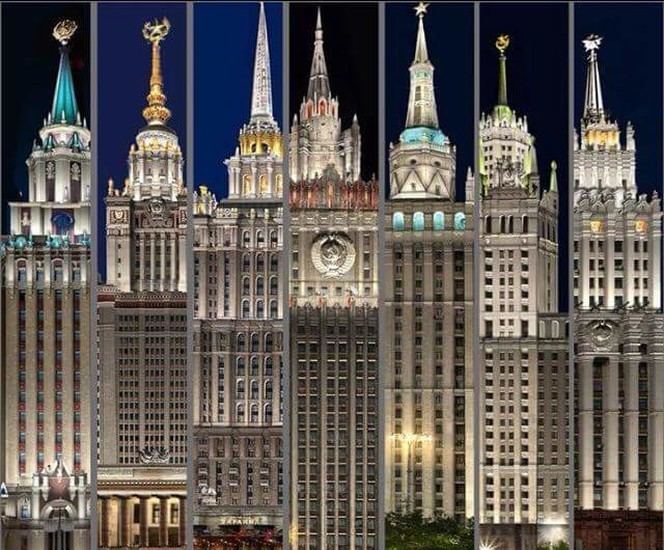 | ||
The Seven Sisters are a group of seven skyscrapers in Moscow designed in the Stalinist style. The term "Seven Sisters" is neither used nor understood by the local population; Muscovites call them Vysotki or Stalinskie Vysotki (Russian: Сталинские высотки), meaning "(Stalin's) high-rises" (or "Stalinist skyscrapers"). They were built from 1947 to 1953, in an elaborate combination of Russian Baroque and Gothic styles.
Contents
- History
- Moscow Buildings
- Moscow State University Sparrow Hills
- Hotel Ukraina Radisson Royal Hotel Moscow
- Ministry of Foreign Affairs
- Hilton Moscow Leningradskaya Hotel
- Kotelnicheskaya Embankment Building
- Kudrinskaya Square Building
- Red Gates Administrative Building
- Zaryadye Administrative Building never built
- Other cities
- Kiev Hotel Moscow Hotel Ukraina
- Warsaw Palace of Culture and Science 19521955
- Bucharest Casa Presei Libere 19521956
- Prague Hotel Druba 19521954
- Riga Latvian Academy of Sciences 19511961
- Related buildings
- Triumph Palace Moscow 2003
- Triumph of Astana 2006
- References
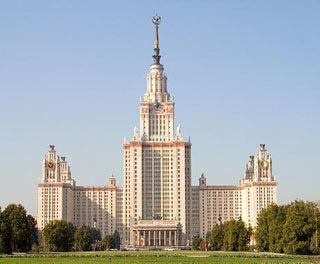
The seven are: Hotel Ukraina, Kotelnicheskaya Embankment Apartments, the Kudrinskaya Square Building, the Hilton Moscow Leningradskaya Hotel, the Ministry of Foreign Affairs main building, the main building of the Moscow State University, and the Red Gates Administrative Building. There were two more skyscrapers in the same style that were never built: the Zaryadye Administrative Building and the Palace of the Soviets.
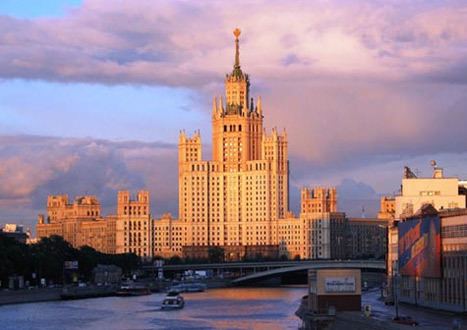
History
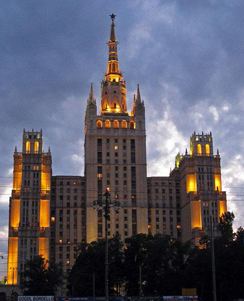
The construction of the first Soviet skyscraper project, Palace of the Soviets, was interrupted by the German invasion of 1941, at which point the steel frame was scrapped in order to fortify the Moscow defense ring, and the site was abandoned. Between 1947 and 1956, Boris Iofan presented six new drafts for this site, and also for Vorobyovy Gory on a smaller scale — they were all rejected. In 1946, Stalin personally switched to another idea — construction of vysotki, a chain of reasonably-sized skyscrapers not tarnished by the memories of the Comintern. As Nikita Khrushchev recalled Stalin's words, "We won the war ... foreigners will come to Moscow, walk around, and there are no skyscrapers. If they compare Moscow to capitalist cities, it's a moral blow to us". Sites were selected in between January 1947 (the official decree on vysotki) and September 12, 1947 (formal opening ceremony).
Nothing is known about selection of construction sites or design evaluation; this process (1947–1948) was kept secret, a sign of Stalin's personal tight management. Old professionals like Shchusev, Zholtovsky etc., were not involved. Instead, the job was given to the next generation of mature architects. In 1947, the oldest of them, Vladimir Gelfreikh, was 62. The youngest, Mikhail Posokhin, was 37. Individual commissions were ranked according to each architect's status, and clearly segmented into two groups — four first-class and four second-class towers. Job number one, a Vorobyovy Gory tower that would become Moscow State University, was awarded to Lev Rudnev, a new leader of his profession. Rudnev received his commission only in September 1948, and employed hundreds of professional designers. He released his draft in early 1949. Dmitry Chechulin received two commissions.
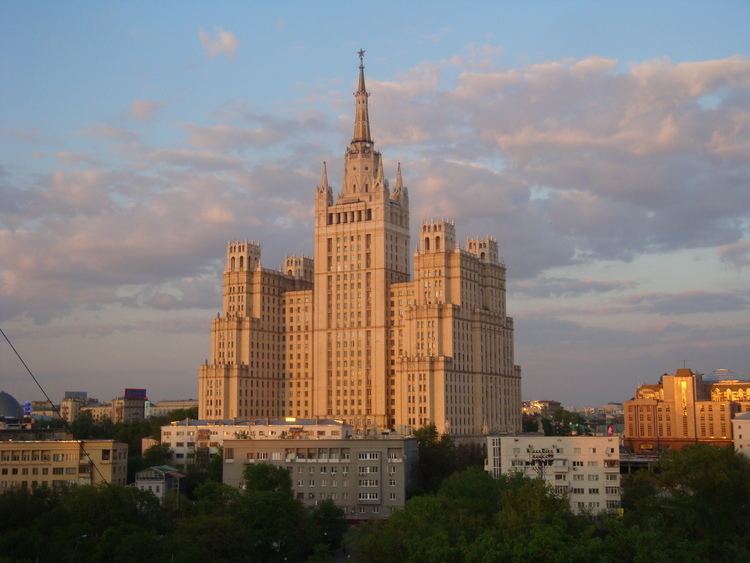
In April 1949, the winner of the Stalin Prize for 1948 was announced. All eight design teams received first and second class awards, according to their project status, regardless of their architectural value. At this stage, these were conceptual drafts; often one would be cancelled and others would be altered.
All the buildings employed over-engineered steel frames with concrete ceilings and masonry infill, based on concrete slab foundations (in the case of the University building — 7 meters thick). Exterior ceramic tiles, panels up to 15 square meters, were secured with stainless steel anchors. The height of these buildings was not limited by political will, but by lack of technology and experience — the structures were far heavier than American skyscrapers.
The effect of this project on real urban needs can be seen from these numbers:
In other words, the resources diverted for this project effectively halved housing construction rates. On the other hand, the new construction plants, built for this project (like Kuchino Ceramics), were fundamental to Khrushchev's residential program just a few years later.
Moscow Buildings
Buildings are listed under their current names, in the same order as they appeared in the April 1949 Stalin Prize decree. Note that different sources report different number of levels and height, depending on inclusion of mechanical floors and uninhabited crown levels.
Moscow State University, Sparrow Hills
Boris Iofan made a mistake placing his draft skyscraper right on the edge of Sparrow Hills. The site was a potential landslide hazard. He made a worse mistake by insisting on his decision and was promptly replaced by Lev Rudnev, a 53-year-old rising star of Stalin's establishment. Rudnev had already built high-profile edifices like the 1932–1937 Frunze Military Academy and the 1947 Marshals' Apartments (Sadovaya-Kudrinskaya, 28), which earned the highest credits of the Party. He set the building 800 meters away from the cliff.
The building was constructed in part by several thousand Gulag inmates. When the construction was nearing completion, some inmates were housed on the 24th and 25th levels to reduce transportation costs and the number of guards required.
The main tower, which consumed over 40,000 metric tons of steel, was inaugurated on September 1, 1953. At 787.4 feet or 240 metres tall, it was the tallest building in Europe from its completion until 1990. It is still the tallest educational building in the world.
Hotel Ukraina – Radisson Royal Hotel, Moscow
Ukraina by Arkady Mordvinov and Vyacheslav Oltarzhevsky (leading Soviet expert on steel-framed highrise construction) is the second tallest of the "sisters" (198 meters, 34 levels). It was the tallest hotel in the world from the time of its construction until the Peachtree Plaza Hotel opened in Atlanta, Georgia in 1975.
Construction on the low river bank meant that the builders had to dig well below the water level. This was solved by an ingenious water retention system, using a perimeter of needle pumps driven deep into ground.
The hotel reopened its doors again after a 3-year-renovation on April 28, 2010, now called Radisson Royal Hotel, Moscow, with 505 bedrooms and 38 apartments.
Ministry of Foreign Affairs
This 172 meter, 27 story building was built between 1948 and 1953 and overseen by V.G.Gelfreih and A.B.Minkus. Currently, it houses the offices for the Ministry of Foreign Affairs for the Russian Federation. The Ministry is covered by a light external stone wall with projecting pilasters and pylons. Its interior is splendidly decorated with stones and metals. According to the 1982 biography of Minkus, draft plans were first drawn up in 1946 and ranged from 9 to 40 stories. In 1947 two designs were proposed: one used layered setbacks while the other called for a more streamlined construction which culminated into a blunt rectangular top. The second proposal was accepted but as the Ministry's completion neared, a metal spire, dyed to match the building's exterior (and presumably ordered by Joseph Stalin), was hastily added to tower's roof, assimilating its silhouette with those of the other Sisters.
Hilton Moscow Leningradskaya Hotel
Originally known simply as the Leningradskaya Hotel, this relatively small (136 meters, 26 floors, of which 19 are usable) building by Leonid Polyakov on Komsomolskaya Square is decorated with pseudo-Russian ornaments mimicking Alexey Shchusev's Kazansky Rail Terminal. Inside, it was inefficiently planned. Khruschev, in his 1955 decree "On liquidation of excesses..." asserted that at least 1000 rooms could be built for the cost of Leningradskaya's 354, that only 22% of the total space was rent-able, and that the costs per bed were 50% higher than in Moskva Hotel. Following this critique, Polyakov was stripped of his 1948 Stalin Prize but retained the other one, for a Moscow Metro station. After a multimillion-dollar renovation ending in 2008, the hotel re-opened as the Hilton Moscow Leningradskaya.
Kotelnicheskaya Embankment Building
Another of Chechulin's works, 176 meters high, with 22 usable levels, the Kotelnicheskaya Embankment Building was strategically placed at the confluence of the Moskva River and Yauza River. The building incorporates an earlier 9-story apartment block facing Moskva River, by the same architects (completed in 1940). It was intended as an elite housing building. However, very soon after construction, units were converted to multi-family kommunalka (communal apartments). Built in a neo-gothic design, though also drew inspiration from Hotel Metropol.
Kudrinskaya Square Building
Designed by Mikhail Posokhin (Sr.) and Ashot Mndoyants. 160 metres tall, 22 floors (18 usable in the wings and 22 in the central part). The building is located on the end of Krasnaya Presnya street, facing the Sadovoye Koltso and was primary built with high-end apartments for Soviet cultural leaders rather than politicians.
Red Gates Administrative Building
Designed by Alexey Dushkin of the Moscow Metro fame, this mixed-use block of 11-storey buildings is crowned with a slim tower (total height 133 meters, 24 levels).
In this case, cryotechnology was indeed used for the escalator tunnels connecting the building with the Krasniye Vorota subway station. The building's frame was erected deliberately tilted to one side; when the frozen soil thawed, it settled down – although not enough for a perfect horizontal level. Then the builders warmed the soil by pumping hot water; this worked too well, the structure slightly overreacted, tilting to the opposite side but well within tolerance.
Zaryadye Administrative Building (never built)
In 1934, the Commissariat for Heavy Industries initiated a design contest for its new building on Red Square (on the site of State Universal Store, GUM). A last showcase for constructivists, this contest didn't materialize and GUM still stands.
In 1947, the nearby medieval Zaryadye district was razed to make way for the new 32-story, 275-meter tower (the numbers are quoted as in the 1951 finalized draft). It is sometimes associated with the Ministry of Heavy Machinery, the same institution that ran a contest in 1934. However, in all public documents of this time its name is simply the administrative building, without any specific affiliation. Likewise, association with Lavrentiy Beria is mostly anecdotal.
The tower, designed by Chechulin, was supposed to be the second largest after the University. Eventually, the plans were cancelled at the foundation stage; these foundations were used later for the construction of the Rossiya Hotel (also by Chechulin, 1967, demolished 2006–2007).
Other cities
While many cities in the former USSR and former Soviet Bloc countries have Stalinist towers on top of them, few fall in the same league as the Moscow vysotki. Of these three, Hotel Ukraina in Kiev was completed in stripped-down form, without the tower and steeple originally planned for them.
Kiev: Hotel Moscow – Hotel Ukraina
Plans to build a skyscraper on the site of the destroyed Ginzburg Hotel emerged in 1948, but the design was finalized by Anatoly Dobrovolsky as late as 1954, when Stalinist architecture was already doomed. Building work proceeded slowly, with numerous political orders to make it simpler and cheaper. It was completed in 1961, without a tower, steeple and any original ornaments.
Warsaw: Palace of Culture and Science, 1952–1955
Another Lev Rudnev design, with Polish Renaissance Revival detailing. Built in 1952–1955 (topped out October 1953).
Construction plans were agreed upon on April 5, 1952 and sealed during Vyacheslav Molotov's visit on July 3 of the same year (after the opening ceremony on May 1). The Soviets planned it as a university, but the Polish side insisted on its current administrative function. A workforce of around 7000 was nearly evenly split between Poles and exported Soviet laborers; 16 were presumed killed during the work. The building remains the tallest in Poland, but the modern glass skyscrapers surrounding it now are not far behind in terms of height.
Bucharest: Casa Presei Libere, 1952–1956
Construction began in 1952 and was completed in 1956. The building was named Combinatul Poligrafic Casa Scînteii "I.V.Stalin" and later Casa Scînteii (Scînteia was the name of the Romanian Communist Party's official newspaper). It was designed by the architect Horia Maicu, and was intended to house all of Bucharest's printing presses, the newsrooms and their staff. Its height is 91.6 m (301 ft) without the television antenna, which measures an additional 12.4 m (41 ft).
Prague: Hotel Družba, 1952–1954
The largest Stalinist architecture building in Prague, Czech Republic. The building was built between 1952 and 1954 at the order of Defence minister Alexej Čepička. It is 88 m high (the roof is 67 m, plus a 10 m chalice and a 1.5 m red star) and has sixteen floors. Part of the building was a fallout shelter for 600 people, currently used as a staff clothes room.
Riga: Latvian Academy of Sciences, 1951–1961
Initially planned as House of Kolkhoz workers (Kolhoznieku nams), construction was started in 1951 and finished in 1958, although the building was officially opened only in 1961. Upon finishing the building was turned over to the Latvian Academy of Sciences. It has 21 floors and a conference hall that seats 1000 people.
The 108-meter high Academy is not the tallest building in Riga. Unlike other vysotki, which are based on a steel frame with masonry infill, this is a reinforced concrete structure, the first of its kind in the USSR.
Related buildings
Many Stalinist buildings have tower crowns, but they do not belong to the vysotki project and their style is completely different. This is evident in Chechulin's Peking building. Seen from a low point of the Garden Ring south, it could be mistaken for a skyscraper, but if viewed from Mayakovsky square it is clear that the building is far less imposing. There are also several smaller Stalinesque towers in Barnaul, St. Petersburg and other cities. Design and construction of such towers became widespread in the early 1950s, although many ongoing projects were cancelled in 1955, when regional "skyscrapers" were specifically addressed by Nikita Khrushchev's decree "On liquidation of architectural excesses..." as unacceptable expense.
Triumph Palace, Moscow, 2003
The high-profile Triumph Palace tower in north-western Moscow (3, Chapayevsky Lane), completed in December, 2003, attempts to imitate the vysotki, and actually exceeds the University building in structural height. It is criticized for being placed deeply inside a residential mid-rise area, away from major avenues and squares, where it could be an important visual anchor. A close inspection reveals that this white-red tower has little in common with Stalinist style, except for sheer size and layered tower outline. It competes for the 'Eighth Vysotka' title with an earlier Edelweiss Tower in western Moscow. Construction began in 2001. The 57-story building, containing about 1,000 luxury apartments, was topped out on December 20, 2003, making it Europe's tallest building at 264.1 metres or 867 feet. The previous title holder was the Commerzbank Tower in Frankfurt. From 2010 to mid-2012, the tallest building in Moscow (and Europe) was the 306 metres (1,004 ft) Moscow Tower of the City of Capitals complex, until overtaken on July 5, 2012 (official inauguration day) by London's The Shard skyscraper.
Triumph of Astana, 2006
The Triumph of Astana is a 142-metre (466 ft), 39-story residential building in the Kazakhstan capital that was completed in 2006. Modeled after 1950s Soviet high-rise buildings, the complex includes home cinema, restaurants, a center of children’s development, and a shopping center.
